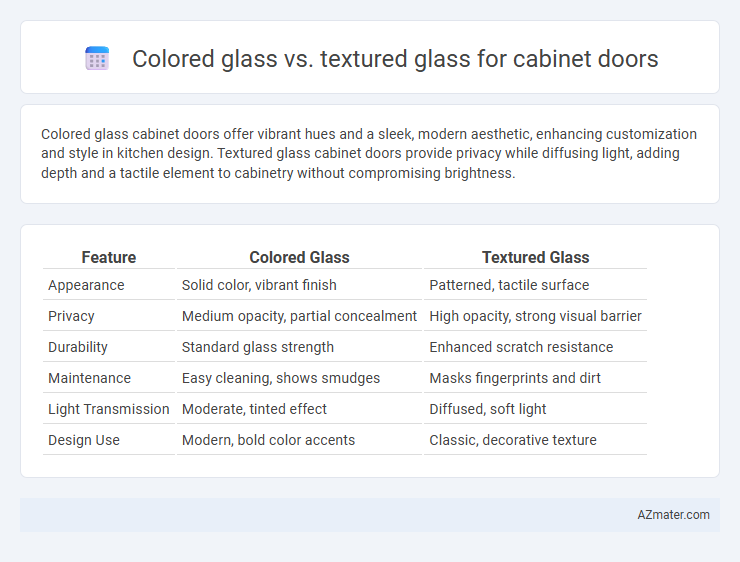Colored glass cabinet doors offer vibrant hues and a sleek, modern aesthetic, enhancing customization and style in kitchen design. Textured glass cabinet doors provide privacy while diffusing light, adding depth and a tactile element to cabinetry without compromising brightness.
Table of Comparison
| Feature | Colored Glass | Textured Glass |
|---|---|---|
| Appearance | Solid color, vibrant finish | Patterned, tactile surface |
| Privacy | Medium opacity, partial concealment | High opacity, strong visual barrier |
| Durability | Standard glass strength | Enhanced scratch resistance |
| Maintenance | Easy cleaning, shows smudges | Masks fingerprints and dirt |
| Light Transmission | Moderate, tinted effect | Diffused, soft light |
| Design Use | Modern, bold color accents | Classic, decorative texture |
Introduction to Decorative Cabinet Glass Options
Colored glass offers vibrant hues that enhance cabinet doors with a bold visual statement, providing a customizable palette to match interior design themes. Textured glass introduces depth and dimension through patterns like rain, reed, or frosted effects, adding privacy while diffusing light elegantly. Both options serve as functional decorative elements that elevate cabinetry aesthetics and protect contents without compromising style.
What is Colored Glass for Cabinet Doors?
Colored glass for cabinet doors is glass tinted with pigments or dyes to provide a vibrant or subdued hue, enhancing the aesthetic appeal and complementing interior design themes. It offers a smooth, sleek surface that is easy to clean and resistant to stains and moisture, ideal for kitchen or bathroom cabinetry. Unlike textured glass, colored glass emphasizes color uniformity and transparency, allowing for creative light diffusion while maintaining visual clarity.
What is Textured Glass for Cabinet Doors?
Textured glass for cabinet doors features raised patterns or designs that add depth and visual interest while obscuring the view of the cabinet's contents. It enhances privacy and hides fingerprints or smudges better than clear glass, making it practical for kitchen or bathroom cabinetry. Unlike colored glass, textured glass maintains a neutral appearance, blending seamlessly with various interior styles.
Visual Impact: Colored vs Textured Glass
Colored glass cabinet doors offer a bold visual impact by introducing vibrant hues that can complement or contrast with surrounding cabinetry, creating a dynamic focal point. Textured glass provides subtle visual interest through patterns and surface variations, enhancing privacy while diffusing light for a softer, more elegant appearance. Both options serve to elevate kitchen aesthetics, with colored glass emphasizing color intensity and textured glass highlighting tactile and light-play qualities.
Privacy and Light Diffusion Comparison
Colored glass for cabinet doors enhances privacy by obscuring visibility while allowing light to pass through, creating a vibrant yet concealed interior view. Textured glass diffuses light effectively by scattering it, which softens illumination and masks contents without the use of color. Both options balance privacy and light diffusion, with colored glass offering more vivid aesthetics and textured glass providing subtler transparency control.
Design Versatility and Style Choices
Colored glass cabinets offer vibrant hues that enhance modern and eclectic kitchen designs, providing bold focal points and personalized style options. Textured glass varieties like frosted, ribbed, or hammered add depth and subtle privacy, blending seamlessly with traditional or transitional cabinetry for a refined, tactile aesthetic. Both options cater to diverse design preferences, with colored glass emphasizing vivid color schemes and textured glass prioritizing understated elegance and light diffusion.
Durability and Maintenance Considerations
Colored glass for cabinet doors offers strong resistance to scratches and fading, making it highly durable and easy to maintain with just regular cleaning using non-abrasive solutions. Textured glass, while visually appealing, can trap dust and grease in its crevices, requiring more frequent and meticulous cleaning to preserve its appearance. Both types resist moisture and stains well, but colored glass provides a smoother surface that simplifies maintenance for long-term durability.
Cost Comparison: Colored vs Textured Glass
Colored glass cabinet doors typically cost 15-30% more than standard textured glass due to the specialized pigments and production processes involved. Textured glass, such as frosted or patterned styles, offers a more affordable option while still providing privacy and aesthetic appeal. Budget-conscious homeowners often prefer textured glass for its lower price point without sacrificing design flexibility.
Best Applications for Each Glass Type
Colored glass cabinet doors enhance modern kitchens and bathrooms by adding vibrant hues and a sleek, polished look, ideal for accent walls and contemporary designs that require a bold statement. Textured glass cabinet doors offer privacy and hide clutter, making them perfect for traditional or rustic kitchens and areas where diffused light and subtle aesthetics are preferred. Choosing colored glass works best for showcasing glassware and decorative items, while textured glass excels in concealing cabinet contents while maintaining a stylish appearance.
Choosing the Right Glass for Your Cabinet Doors
Colored glass offers vibrant hues that add a bold, modern aesthetic to cabinet doors, enhancing kitchen or bathroom designs with personalized style. Textured glass provides privacy and visual interest by obscuring the view while allowing light to pass through, ideal for concealing contents without sacrificing brightness. Selecting the right glass depends on desired transparency, maintenance needs, and overall design goals, balancing functionality with decorative impact.

Infographic: Colored glass vs Textured glass for Cabinet door
 azmater.com
azmater.com